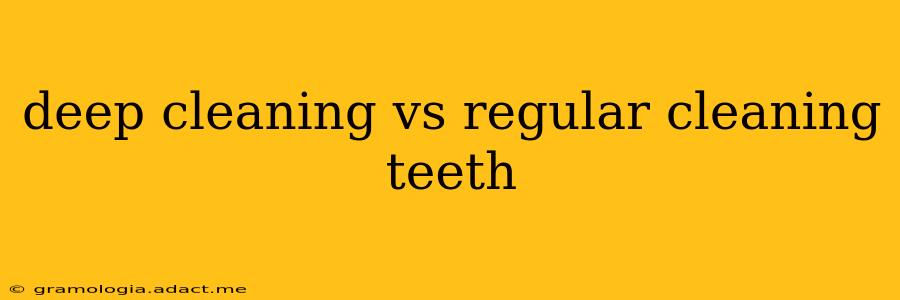Maintaining optimal oral hygiene is crucial for overall health. While regular brushing and flossing form the cornerstone of good oral care, understanding the differences between regular cleaning and deep cleaning is essential for preventing serious dental problems. This comprehensive guide will delve into the specifics of both, highlighting their importance and helping you make informed decisions about your dental health.
What is Regular Teeth Cleaning?
Regular teeth cleaning, also known as a professional cleaning or prophylaxis, is a preventative procedure performed by a dental hygienist or dentist. It typically involves:
- Scaling: Removing plaque and tartar (calculus) from the surfaces of your teeth above and just below the gum line using specialized instruments. Plaque is a sticky film of bacteria that constantly forms on teeth. If not removed regularly, it hardens into tartar, which can only be removed professionally.
- Polishing: Smoothing the tooth surfaces to remove stains and make it more difficult for plaque to adhere. This helps improve the overall appearance of your teeth.
- Dental exam: A thorough examination of your teeth and gums by the dentist to detect any potential problems like cavities, gum disease, or oral cancer.
Regular cleanings are typically recommended every six months, although this can vary depending on individual needs and oral health. This preventative measure significantly reduces your risk of developing gum disease and cavities.
What is Deep Cleaning of Teeth?
Deep cleaning, also known as scaling and root planing, is a more extensive procedure necessary for individuals with moderate to severe gum disease (periodontitis). It goes beyond the surface cleaning of regular cleanings, addressing the deeper issues beneath the gum line. The process involves:
- Scaling: Removing plaque and tartar from both above and below the gum line, often using ultrasonic instruments for efficiency and precision. This removes the bacteria that cause inflammation and infection.
- Root planing: Smoothing the tooth roots to remove rough surfaces where bacteria can accumulate. This helps the gums reattach to the teeth, reducing inflammation and improving gum health.
Deep cleaning is typically performed over two or more appointments, as it is a more involved process than a regular cleaning. It might also involve local anesthesia to ensure comfort during the procedure. Post-procedure, careful at-home oral hygiene is essential for maintaining the results and preventing recurrence.
How Often Should You Get a Deep Cleaning?
The frequency of deep cleaning depends entirely on the individual's periodontal condition and response to treatment. A dentist will determine the appropriate interval, which can range from every few months to once a year, or even less frequently once periodontal health improves significantly.
What are the Signs You Need a Deep Cleaning?
Several signs can indicate the need for a deep cleaning:
- Bleeding gums: Consistent bleeding while brushing or flossing is a common sign of gum inflammation.
- Swollen gums: Swollen, red, or tender gums suggest gum disease.
- Receding gums: Gums pulling away from the teeth, exposing more of the tooth root.
- Persistent bad breath: Bad breath that persists despite good oral hygiene practices can be a symptom of gum disease.
- Loose teeth: Teeth becoming loose are a serious indicator of advanced gum disease.
- Pus around the teeth: Noticeable pus around the teeth is a clear sign of infection.
If you experience any of these symptoms, it's crucial to schedule an appointment with your dentist immediately.
What is the Difference Between Deep Cleaning and Regular Cleaning?
The primary difference lies in the depth of cleaning and the targeted areas. Regular cleaning focuses on the surfaces of the teeth above the gum line, preventing the buildup of plaque and tartar. Deep cleaning, however, addresses the deeper pockets beneath the gum line, removing bacteria and promoting gum reattachment. Deep cleaning is a therapeutic procedure addressing existing gum disease, while regular cleaning is primarily preventative.
Is Deep Cleaning Painful?
While some discomfort is possible, deep cleaning is typically not intensely painful. Local anesthesia is often used to minimize any discomfort during the procedure. Post-procedure, some soreness or sensitivity may occur, but this usually subsides within a few days. Over-the-counter pain relievers can help manage any discomfort.
Can Deep Cleaning Damage Teeth?
When performed by a qualified dentist or hygienist, deep cleaning does not damage teeth. The procedure is designed to remove harmful bacteria and improve gum health, ultimately protecting the teeth and supporting their longevity. However, improper technique can potentially damage the teeth or gums, highlighting the importance of choosing a qualified professional.
How Much Does a Deep Cleaning Cost?
The cost of a deep cleaning varies depending on several factors including location, the extent of the procedure, and insurance coverage. It is usually more expensive than a regular cleaning because it requires more time and expertise. It's best to contact your dental insurance provider and your dentist directly to understand the estimated cost in your specific situation.
By understanding the nuances of regular and deep teeth cleaning, you can actively participate in maintaining optimal oral health and preventing serious dental issues. Remember, regular checkups and professional cleanings are key investments in your overall well-being.
